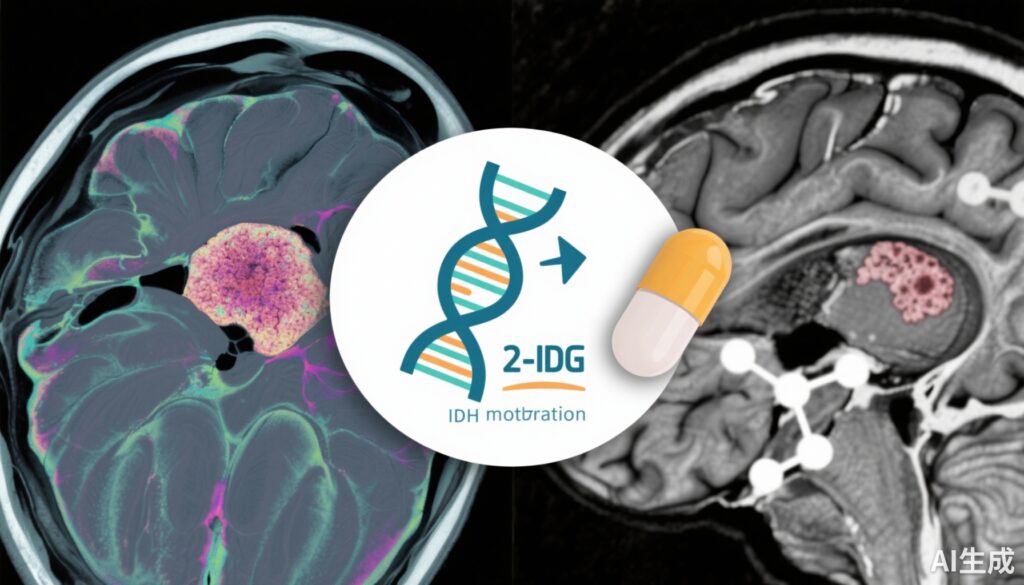Highlights
– Vorasidenib, an oral brain‑penetrant IDH1/2 inhibitor, significantly improved progression‑free survival (PFS) and time to next intervention versus placebo in patients with grade 2 IDH‑mutant diffuse glioma.
– Vorasidenib markedly reduced 6‑monthly volumetric tumour growth rate (mean −1.3% vs 14.4% with placebo) and was associated with fewer seizures (18.2 vs 51.2 seizures per person‑year).
– Health‑related quality of life (FACT‑Br) and multiple domains of neurocognitive function were preserved; no treatment‑related deaths observed. Liver enzyme elevations and seizures were the most common grade ≥3 adverse events with vorasidenib.
Background: clinical context and unmet need
Diffuse grade 2 gliomas that harbor isocitrate dehydrogenase 1 or 2 (IDH1/2) mutations comprise a biologically distinct subgroup of lower‑grade gliomas that typically affect younger adults and often present with seizures. IDH mutations drive tumour biology through production of the oncometabolite D‑2‑hydroxyglutarate (2‑HG), producing epigenetic and metabolic changes that promote tumorigenesis.
Management of IDH‑mutant grade 2 glioma after initial surgery traditionally ranges from early adjuvant radiotherapy and/or chemotherapy to active surveillance (‘watchful waiting’), depending on risk factors and patient preferences. Radiotherapy and temozolomide can improve disease control but carry risks of late neurocognitive decline and other toxicities. Thus, effective, brain‑penetrant targeted therapies that can delay or avoid early cytotoxic treatment while preserving cognition and quality of life would address a meaningful unmet need.
Study design (INDIGO trial)
INDIGO (NCT04164901) is a global, randomized, double‑blind, placebo‑controlled phase 3 trial conducted at 92 sites across North America, Europe, Israel, Japan, and other regions. Eligible patients were aged ≥12 years with residual or recurrent WHO grade 2 diffuse glioma harboring IDH1 or IDH2 mutation, Karnofsky performance status ≥80, at least one prior surgery, and no prior radiotherapy or chemotherapy for glioma.
Participants were randomized 1:1 to oral vorasidenib 40 mg daily or matched placebo in continuous 28‑day cycles until progression or unacceptable toxicity. The trial stratified randomization by locally determined 1p/19q codeletion status and baseline tumour size.
The primary endpoint was independent‑review committee assessed progression‑free survival (PFS). Key secondary and prespecified endpoints included time to next intervention, 6‑monthly volumetric tumour growth rate, health‑related quality of life (FACT‑Br), neurocognitive function (battery of cognitive performance instruments), and self‑reported seizure activity. Efficacy analyses used the full analysis set (all randomized patients); safety analyses included all patients who received at least one dose.
Key findings
Population and follow‑up
Between Jan 9, 2020 and Feb 22, 2022, 331 patients were randomized to vorasidenib (n=168) or placebo (n=163). Median follow‑up at the time of the reported analysis was 20.1 months (IQR 15.9–23.8). The cohort was predominantly adult (≥12 years eligible), with 56% male and 78% White.
Primary and key secondary endpoints
At second interim analysis and with an additional ≈6 months of blinded follow‑up (to unblinding on March 7, 2023), vorasidenib continued to show a large benefit in PFS and time to next intervention. Median PFS remained not reached in the vorasidenib arm versus 11.4 months (95% CI 11.1–13.9) with placebo (hazard ratio [HR] 0.35, 95% CI 0.25–0.49). Time to next intervention was also substantially delayed with vorasidenib (median not estimable) versus 20.1 months (95% CI 17.5–27.1) with placebo (HR 0.25, 95% CI 0.16–0.40).
These effect sizes represent robust reductions in risk of radiographic progression and in the need for additional cytotoxic or radiotherapeutic interventions in this post‑surgical, treatment‑naïve population.
Tumour growth rate
A prespecified imaging‑based analysis of volumetric tumour growth rate (6‑monthly percentage change) showed a mean change of −1.3% (95% CI −3.2 to 0.7) in the vorasidenib group versus +14.4% (95% CI 12.0 to 16.8) in the placebo group, for an absolute difference of 15.9% (95% CI 12.6–19.3). This quantitative reduction in volumetric expansion corroborates the PFS findings and suggests true biologic slowing of tumour progression attributable to IDH inhibition.
Seizure control
Seizures, a common presenting and ongoing symptom in low‑grade glioma, were reduced with vorasidenib: 18.2 seizures per person‑year (95% CI 8.4–39.5) versus 51.2 seizures per person‑year (95% CI 22.9–114.8) with placebo. This clinically meaningful decrease in seizure burden is an important patient‑centered outcome, given the morbidity of seizures and their adverse impact on quality of life, driving treatment decisions in many patients.
Health‑related quality of life and neurocognition
FACT‑Br total scores were high at baseline and remained comparable between arms through end of treatment (baseline mean 158.2 vs 158.8; end‑of‑treatment 154.2 vs 153.2 for vorasidenib vs placebo). Prespecified neurocognitive assessments showed no difference between arms across domains including verbal learning, executive function, attention, working memory, and psychomotor function from baseline through end of treatment.
Preservation of HRQOL and neurocognitive function alongside disease control is clinically important when considering alternatives that can cause late cognitive decline (notably radiotherapy) in a typically younger patient population.
Safety
Treatment‑emergent adverse events (TEAEs) of grade ≥3 were more frequent with vorasidenib for several liver enzyme abnormalities: increased alanine aminotransferase (ALT) occurred in 17 patients (10%) on vorasidenib vs 2 (1%) on placebo; increased aspartate aminotransferase (AST) in 8 (5%) vs 0; increased γ‑glutamyltransferase in 5 (3%) vs 2 (1%). Seizures as a grade ≥3 TEAE were reported in 7 (4%) vs 5 (3%). Serious TEAEs occurred in 20 (12%) patients receiving vorasidenib versus 10 (6%) with placebo; the most common serious events were seizures. There were no treatment‑related deaths.
Overall, vorasidenib was associated with hepatic biochemical toxicity that warrants monitoring and management but without treatment‑related mortality in this dataset.
Expert commentary and interpretation
INDIGO provides the strongest randomized evidence to date that a selective, brain‑penetrant IDH inhibitor can alter the natural history of IDH‑mutant grade 2 glioma. The combination of a large PFS improvement, major reduction in volumetric growth rate, fewer seizures, and preserved quality of life/neurocognition supports a strategy in which vorasidenib may be offered to patients who have undergone surgery and are not in immediate need of radiotherapy or chemotherapy.
Biological plausibility is strong: IDH mutations generate 2‑HG, which alters epigenetic regulation and fosters a tumour‑permissive state; inhibition of mutant IDH enzymes reduces 2‑HG levels and can diminish oncogenic signalling in preclinical models. Vorasidenib was developed specifically for central nervous system penetration, addressing a key limitation of some earlier IDH inhibitors with poor brain availability.
Clinical relevance
Time to next intervention is particularly meaningful in this population because deferment of radiotherapy and alkylating chemotherapy can delay therapy‑related cognitive decline, secondary malignancy risk, and cumulative toxicity. Reduced seizure frequency itself may justify therapy even absent overt radiographic shrinkage for some patients.
Limitations and open questions
Key limitations include median follow‑up of ≈20 months, with overall survival data immature; it remains unknown whether PFS prolongation will translate into OS benefit or long‑term functional gains. The trial population excluded patients who had prior radiotherapy or chemotherapy, and had relatively high baseline performance status, which may limit generalizability to older, frailer, or heavily pretreated patients.
Longer follow‑up is required to define durability of response, late toxicities (including hepatic and neurologic complications), resistance mechanisms to IDH inhibition, and potential interactions with later radiotherapy or chemotherapy. Cost, access, and regulatory decisions will also shape adoption in clinical practice.
Practical considerations for clinicians
For patients with resected IDH‑mutant grade 2 glioma who are candidates for observation, vorasidenib offers a targeted systemic option to slow radiographic progression and reduce seizures while preserving cognition and HRQOL. Shared decision‑making should weigh the benefits against the need for regular liver monitoring, the possibility of serious TEAEs, and the absence of mature OS data.
Clinicians should confirm IDH mutation status (molecular testing) and discuss that the INDIGO population specifically included patients without prior radiotherapy or chemotherapy; safety monitoring per trial protocol (including hepatic panels) is essential when using vorasidenib.
Conclusion and research priorities
INDIGO demonstrates that vorasidenib delivers clinically meaningful slowing of tumour growth, prolongation of PFS and time to next intervention, and reduction in seizure burden without compromising HRQOL or neurocognition in patients with grade 2 IDH1/2‑mutant diffuse glioma post‑surgery. These data support vorasidenib as a treatment option for patients who wish to defer radiotherapy or chemotherapy.
Important next steps include longer follow‑up for overall survival and neurocognitive outcomes, studies in broader or more diverse clinical populations, investigation of combination strategies (for example, sequencing with radiotherapy/chemotherapy), and translational work to characterize mechanisms of resistance and biomarkers that predict durable benefit.
Funding and trial registration
The INDIGO trial was funded by Servier. ClinicalTrials.gov identifier: NCT04164901.
Selected references
1. Cloughesy TF, van den Bent MJ, Touat M, et al.; INDIGO trial investigators. Vorasidenib in IDH1‑mutant or IDH2‑mutant low‑grade glioma (INDIGO): secondary and exploratory endpoints from a randomised, double‑blind, placebo‑controlled, phase 3 trial. Lancet Oncol. 2025 Oct 29:S1470‑2045(25)00472‑3. doi:10.1016/S1470‑2045(25)00472‑3. PMID: 41175888.
2. Louis DN, Perry A, Wesseling P, et al. The 2021 WHO Classification of Tumors of the Central Nervous System: a summary. Neuro Oncol. 2021;23(8):1231–1251. doi:10.1093/neuonc/noab106.
3. Dang L, White DW, Gross S, et al. Cancer‑associated IDH1 mutations produce 2‑hydroxyglutarate. Nature. 2009;462(7274):739–744. doi:10.1038/nature08617.
Article provenance and authorship
This article was prepared by an independent medical writer synthesizing the INDIGO trial publication and contextual literature to provide clinicians with a balanced interpretation of trial results and practical considerations for clinical implementation.



